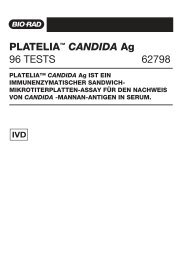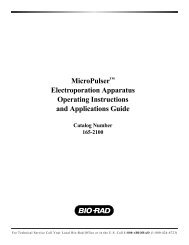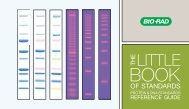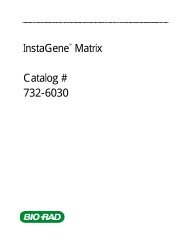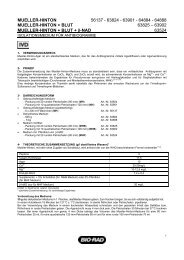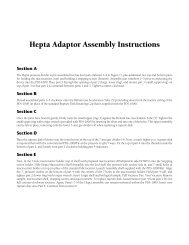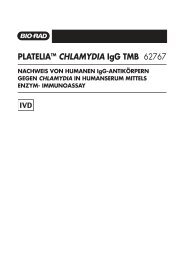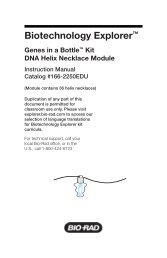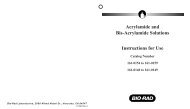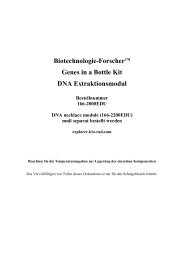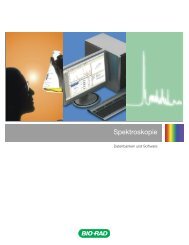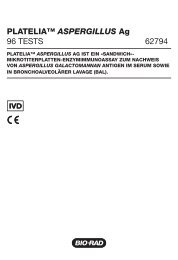Protein Expression and Purification Series - Bio-Rad
Protein Expression and Purification Series - Bio-Rad
Protein Expression and Purification Series - Bio-Rad
Create successful ePaper yourself
Turn your PDF publications into a flip-book with our unique Google optimized e-Paper software.
<strong>Protein</strong> <strong>Expression</strong> <strong>and</strong> <strong>Purification</strong> <strong>Series</strong><br />
Appendix I: Glossary<br />
Absorbance – The amount of ultraviolet light that is not transmitted (absorbed) through a sample. 280 nm<br />
is the ultraviolet wavelength absorbed by the tryptophan, tyrosine, <strong>and</strong> phenylalanine groups in a protein in<br />
solution. The relationship between absorbance of the ultraviolet light <strong>and</strong> protein concentration is linear.<br />
Affinity chromatography – A chromatography method of separating molecules based on a highly specific<br />
biologic interaction such as that between an antigen <strong>and</strong> antibody, enzyme <strong>and</strong> substrate, or receptor <strong>and</strong><br />
lig<strong>and</strong>.<br />
Anion – A negatively charged ion or biomolecule.<br />
Anode – Positive electrode; attracts negative ions.<br />
Anion exchange chromatography – A chromatography method where a positively charged<br />
chromatography resin binds negatively charged molecules, or anions.<br />
Aromatic amino acid groups – Amino acid groups that contain an aromatic ring in the R-group<br />
are nonpolar <strong>and</strong> absorb untraviolet light at 280 nm. Aromatic amino acids are tyrosine (Y, Tyr),<br />
tryptophan (W, Trp), <strong>and</strong> Phenylalanine (F, Phe).<br />
β-mercaptoethanol – (BME) is a reducing agent used to break the diusulfide bonds of proteins, thus<br />
disrupting the tertiary <strong>and</strong> quaternary structure of the protein. It helps to linearize the protein in prepartion<br />
for electrophoresis.<br />
Bradford <strong>Protein</strong> Assay – A test used to measure protein concentration in a sample. The assay relies on<br />
the shift in absorbance of Coomassie Brilliant Blue G-250 dye. The dye reacts with mainly basic amino acid<br />
<strong>and</strong> aromatic amino acid groups.<br />
Buffer – The liquid that is used to dissolve the biomolecules that will be applied to the chromatography<br />
column.<br />
Cathode – Negative electrode; attracts positive ions.<br />
Cation – A positively charged ion or biomolecule.<br />
Cation exchange chromatography – A chromatography method where negatively charged<br />
chromatography resin binds positively charged molecules, or cations.<br />
Cell lysate – All the components, soluble <strong>and</strong> insoluble, of a cell that have been broken open.<br />
Centrifugation – Spinning a mixture at very high speed to separate heavy <strong>and</strong> light particles. In protein<br />
expression <strong>and</strong> purification, centrifugation results in a “pellet” found at the bottom of the tube, <strong>and</strong> a liquid<br />
“supernatant” that resides above the pellet.<br />
Charge density – The protein’s ratio of charge to mass.<br />
Chromatogram – A visual output of the chromatographic separation. Peaks on the chromatogram<br />
indicate when samples are eluting from the column.<br />
Appendix I: Glossary<br />
241<br />
APPENDIX I<br />
GLOSSARY




